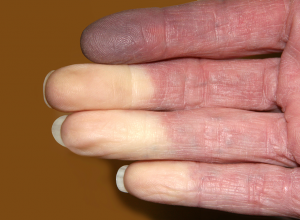
Raynaud’s Phenomenon
Raynaud’s phenomenon, also called Raynaud’s disease or syndrome, is a condition in which some areas of the body — usually the fingers and toes — feel cold and numb in response to cool temperature or stress. It is different from normal cold sensations in that the small arteries that supply blood to the skin significantly narrow, which limits blood supply to the area (a process called vasospasm).
Symptoms
Typical symptoms of Raynaud’s include cold fingers and toes, skin discoloration that varies from white, red to blue when the extremities are exposed to cool temperatures, and a numb or prickly feeling in the fingers and toes when warming or when stress is relieved. The frequency of these symptoms changes based on the severity of the blood vessel spasms associated with the disease.
Though Raynaud’s generally affects the fingers and toes, it can affect and cause similar symptoms in the lips, nose, ears and nipples.
In rare cases, Raynaud’s becomes so severe that blood circulation to the affected areas may diminish completely. This can lead to deformities, sores, skin ulcers and amputation.
Causes
There are two types of Raynaud’s phenomenon: primary and secondary. Primary Raynaud’s appears on its own, while secondary Raynaud’s is caused by an underlying problem such as connective tissue diseases, carpal tunnel syndrome, arterial diseases, eating disorders, taking certain drugs and smoking. Experts don’t fully understand what causes primary Raynaud’s phenomenon, but women are more likely than men to have the condition, as are people who live in cool climates. Primary Raynaud’s may also be genetic.
As described above, Raynaud’s is due to the arteries in the fingers and toes narrowing and limiting blood supply. Sometimes these arteries thicken, which further limits blood flow.
Both external factors (cold temperatures, cold water) and internal factors (emotional stress, anxiety) can trigger a Raynaud’s disease attack.
Treatment
Most cases of Raynaud’s can be managed by wearing proper clothing (thick socks and gloves) in cold climates. When this does not help, your doctor may recommend medication that can reduce the severity of the attacks and prevent tissue damage. Some medications that help with Raynaud’s phenomenon include calcium channel blockers such as nifedipine, alpha blockers such as prazosin and vasodilators such as nitroglycerin cream.
For severe cases of Raynaud’s, nerve surgery and/or chemical injections may be recommended. These procedures may reduce the frequency of attacks, but they are not always successful.
Notice concerning medical entries:
Articles having medical content shall serve exclusively for the purpose of general information. Such articles are not suitable for any (self-) diagnosis and treatment of individual illnesses and medical indications. In particular, they cannot substitute for the examination, advice, or treatment by a licensed physician or pharmacist. No replies to any individual questions shall be effected through the articles.








